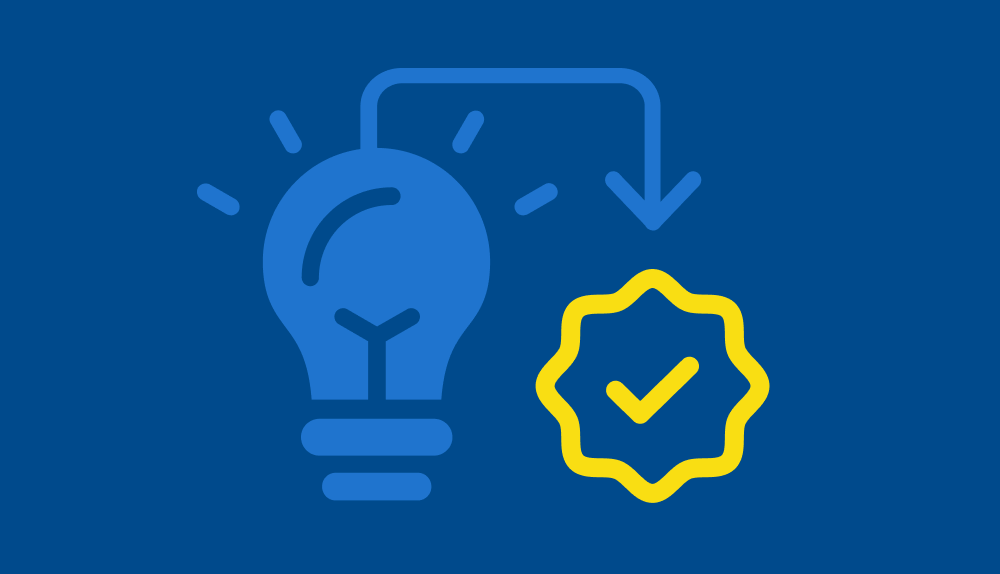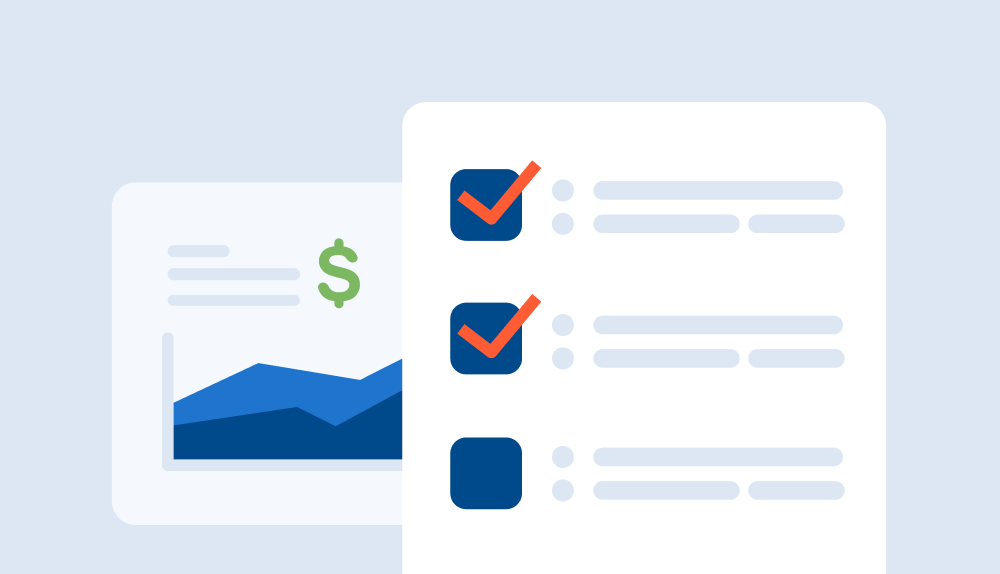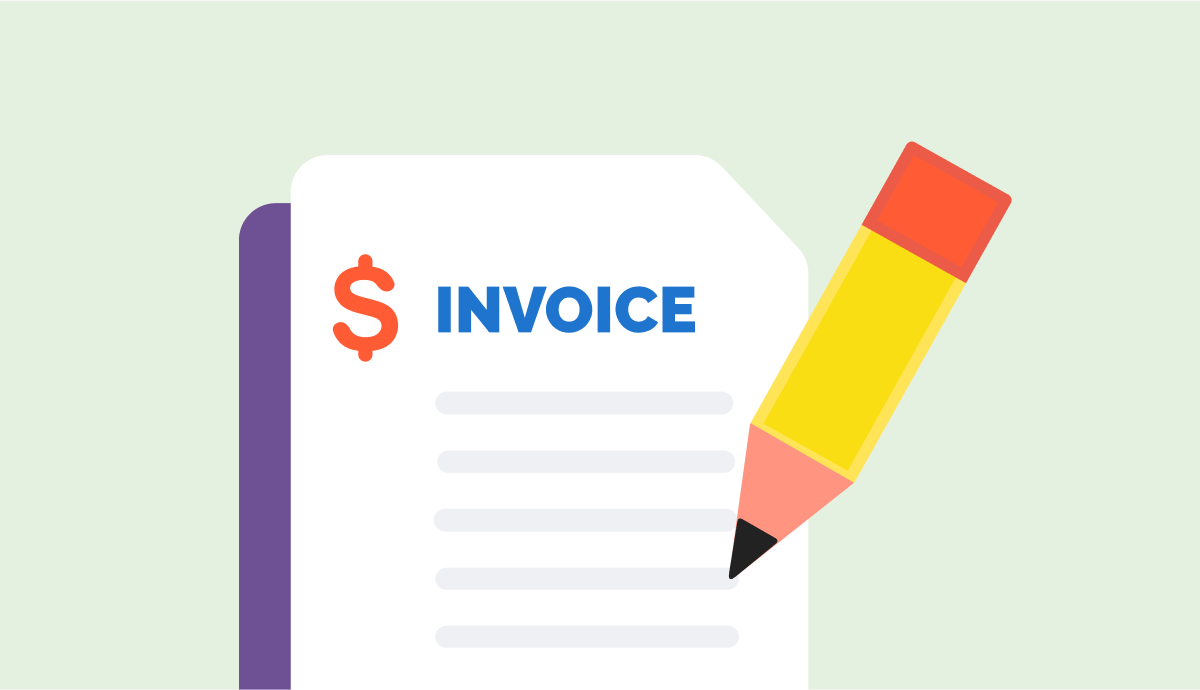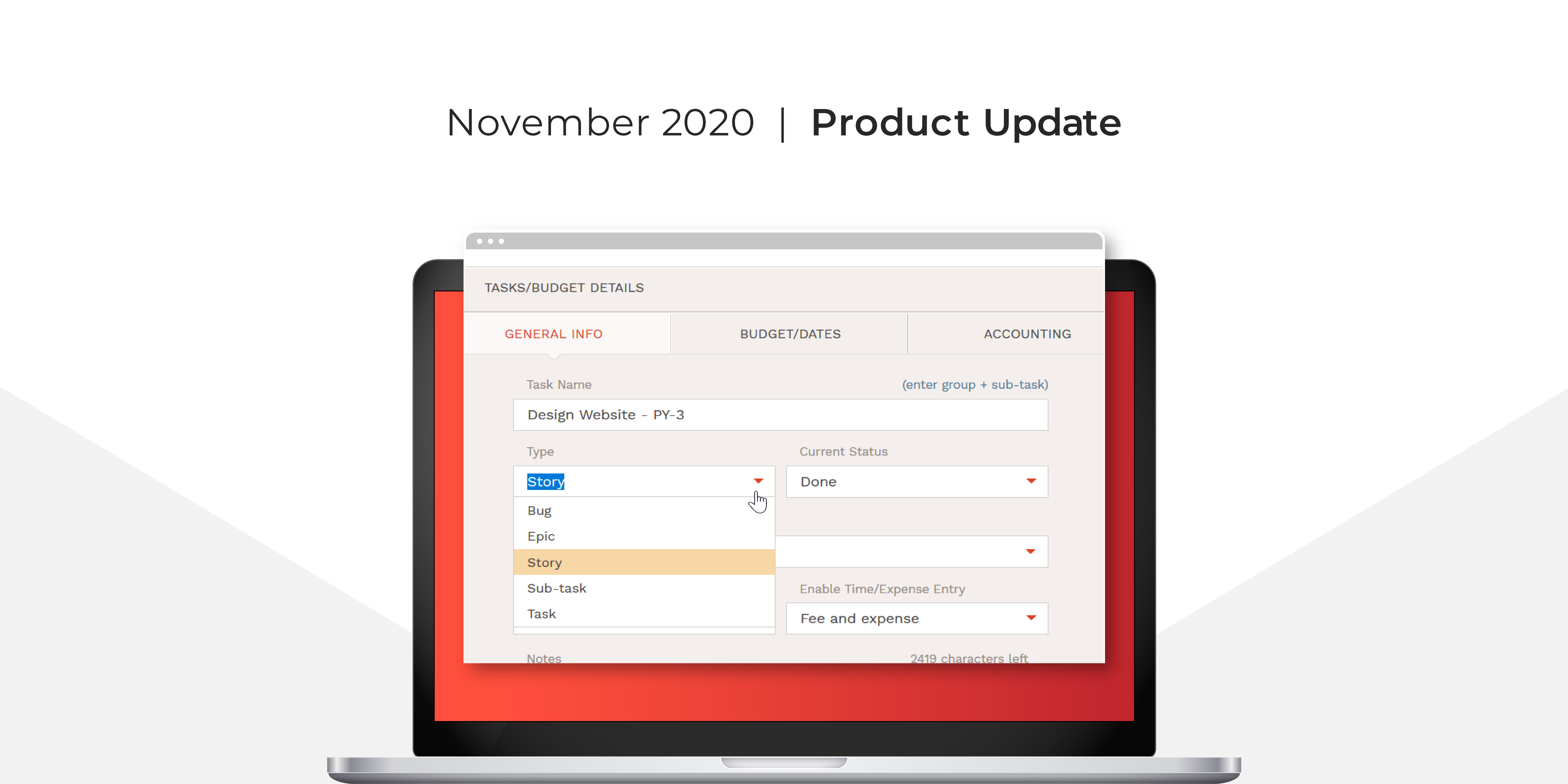Introduction:
With over 20+ years of experience talking to prospective customers, we often hear what we call the “Big 3”.
The 3 most common concerns from prospective customers when selecting Professional Services Automation (PSA) Software — fear of change, gaining commitment from staff, and failure to transition.
Our advice is always the same. The “Big 3” are all avoidable by selecting the PSA system best fit for your firm today, and for where it’s headed. We understand there are many different solutions available, and that BigTime is not always the right answer for everyone. We’re okay with that. PSA is not a one-size-fits-all software, the right solution should feel like it’s tailored exactly to what’s most important for your firm. This guide distills our years of industry knowledge and vast first-hand experience of working with a range of clients to make sure any new customer of ours is a mutual perfect fit.
By using this buyers’ guide, our hope is it gives you confidence in the software decision you make, and trust in the solution you’re persuading internal stakeholders to buy into.
Keeping in mind the current challenges that your firm is facing will navigate you towards asking vendors the right questions. PSA software is the engine that sits at the center of what your organization does, empowering your people to make critical decisions about delivering services and managing resources. It’s important to keep this end goal in mind throughout the entire evaluation process. Once you’ve implemented your PSA solution of choice, you should notice a major shift in these core areas.
Benefits of PSA Software
Save Time with Improved Workflows: Internal processes are streamlined from project creation, tracking resources, approving time and budgets, to sending client invoices and getting paid. Save your team from manual tasks that can be automated so they can spend more time on higher-value activities like billable work. This is how we often see PSAs pay for themselves. The right PSA software should also help you to understand current and planned employee capacity to reduce burnout and glean insight into when to staff more and when to sell more.
Centralized Information: Have one single source of truth to gather all of your firm’s valuable data by integrating data across existing systems to get a complete picture of your project’s health. With real-time insights, you can deliver important professional services KPIs to managers when needed, make rapid decisions when they count, and forecast for the future all in one place. This allows you to become more proactive in how you run your business.
Increased Profitability: Accelerate your business and profits through more accurate management of time, expenses, budgets, project status, and staff capacity. Real-time access to this data gives you a better understanding of whether a project is on budget, right this second, and if it will be on budget next month.

Steps to Evaluating The Best PSA Software for Your Professional Services Business
Get the Big Picture of Your Options
The landscape of PSA software can appear vast, but once you cut through the noise you’ll see how each solution falls into a niche.
Before you find your firm’s perfect match, do yourself the favor of looking broadly so you know you’ve covered the extent of your options. We hear from most prospective buyers that they’re evaluating about 3-5 different software vendors. PSA software review sites are a great place to start your research. G2, Capterra, and Software Advice all provide extensive lists of options available and ratings based on real-user reviews. G2 published a PSA Software Comparison Grid Report so you can save time shifting through PSA software reviews and see an average rating of each software provider based on customer satisfaction, specific features, implementation time, and more.
Once you have the list of PSA solutions you’re interested in, use the discovery call time with each provider to lay out your baseline requirements. Think back to conversations with each stakeholder who will be impacted by this decision: Owners/Principals, Operations, Finance, Project Managers, IT, and Front Line Staff. How are processes currently being handled? What pains were the firm feeling that tipped you to this point? Focus most on what your non-negotiables are over ideals for each major stakeholder in your firm.
Narrow Your Options to Select the Best PSA Solution
Once you feel your big picture is coming together, chances are you already have a couple of options crossed off the list. Now’s the time to see how each software vendor compares where it matters most for your firm. Since PSA software impacts each stage of the lifecycle of an engagement, we recommend you narrow your options by sharing current processes with the vendor to see your firm’s current project workflow replicated in the new solution.
This will quickly highlight what’s working, what’s broken, and what’s better than you expected. Your new software solution may not perfectly mirror every manual step you currently have in place, but remember that’s okay – part of bringing on PSA software is discovering a more efficient way of doing things.
Below we’ve outlined the critical project path of a typical professional services organization to help you start thinking about internal processes with ideas on what questions to ask, features to learn about, and which stakeholders to include in the discussions.
It’s important to note a deep dive into each focus area most likely won’t be necessary. We suggest focusing on what needs additional clarity from your big-picture view or where your biggest pain points and need for customization stem from.
Project and Resource Management
Who to include: Operations, Project Managers
What to consider:
- Real-time budget tracking and management
- Tracking of tasks, time, and expenses for a project
- Review and approval process structures for time and expenses
- Resource planning and management of staff capacity
- Tracking of utilization rates at a project and firm level
Questions to ask:
- Is there visibility into the current and future availability of resources for projects?
- How can you make sure you’ve assigned the best staffer for an open task/project?
- Is there insight into skills and costs for managers to plan for the highest profitability?
- Where can I get a pulse on the overall health of a project?
- Is the data displayed in real-time so I can take corrective action if needed to get budgets on track?
- Will engagements come over from my CRM so that I can predict the flux of future projects?
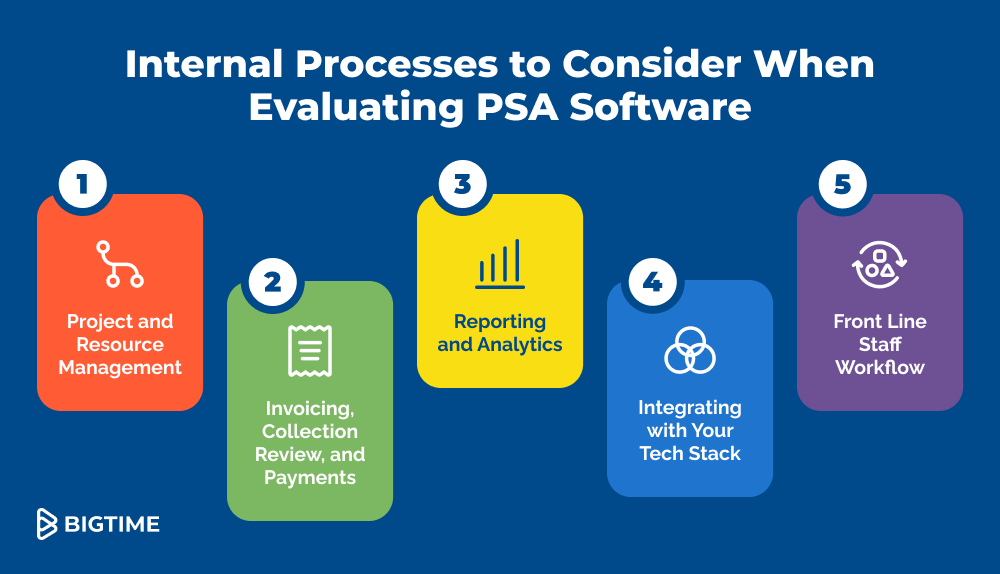
Invoicing, Collection Review, and Payments
Who to include: Finance
What to consider:
- Billing models available and configuration allowed
- Custom branding (company logos, fonts, colors)
- Flexible invoice templates to customize based on client needs
- Ability to add expense receipts
- Review and approval workflows for invoices
- Collecting invoice payments on time
- Option to collect payment via ACH or credit card
Questions to ask:
- Will the software connect to our BI or data warehouse for additional insights?
- How can I keep track of contractor and vendor bills?
- Can the software handle transactions in multiple currencies and how does it work?
- What options are available for sharing professional services invoices and project information with clients?
- Is your payment system secure and PCI compliant?
Reporting and Analytics
Who to include: Operations, Finance, and Principals
What to consider:
- Real-time reporting for the KPIs needed to scale your business including:
- Job costing and project margins
- Client realization and project profitability
- Budget vs actuals
- AR collections and accounts payable
- Expense reimbursements
- Revenue forecasting
- Customization options to filter data
- Adjustable user rights for reports
- Easy-to-digest visuals
- Big picture view into staff utilization and project vitals
Questions to ask:
- Are there forecasting capabilities so you can take corrective action on current projects and adjust job costs for the future?
- Is there a place to get a live look at work-in-progress (WIP) with unbilled time and expenses?
- Will this solution act as the consistent source of truth for business analytics and decision-making?
- Can notifications and alerts be sent to warn teams when budgets have gone over or are close to it?
- How can I adjust staff capacity planning in real time based on utilization insights?
- Is there the ability to see which projects are the most profitable for my firm?
Integrating with Your Tech Stack
Who to include: IT Managers and Operations
What to consider:
- Accounting software (QuickBooks, Sage Intacct, Intuit Lacerte)
- Customer Relationship Management (CRM) platforms (Salesforce, Hubspot)
- Project management software (Jira, Asana, Smartsheet)
- Communication software (Slack, Google apps)
Questions to ask:
- Will the current software we have for accounting, CRM, PM, and communication tools integrate with the PSA solution?
- Are the integrations two-way with a bidirectional sync?
- What type of information is being shared back and forth with your CRM? What is the transaction sync like with your accounting software? How do you exchange work breakdown data with PM tools?
- What types of notifications and messages can be shared with a collaboration tool?
- If we ever want to switch our project accounting software what will that look like for our PSA system?
Front Line Staff Workflow
Who to include: Operations and Front Line Staff
What to consider:
- How quick and easy it is to submit time and expenses
- Custom user rights and defaults to reduce errors
- Option to make fields required
- DCAA compliant time tracking (if applicable)
Questions to ask:
- Are there options for staff to enter time and expenses remotely?
- Can you apply credit card charges to a project?
- What will the onboarding process be like for staffers?
- How quickly can we get consultants up and running tracking time?

What Else to Consider (Product Features & Workflows Aside)
One of the last steps in your top PSA software evaluation process should be looking at how long it will take you to get off the ground and running. Easy adoption and implementation are key when searching for a solution that is supposed to save you time and money.
Equally important is how supported your firm will be by the software provider throughout the partnership. If the goal of the PSA solution is achieved, your firm will be scaling and business needs will change as you grow.
For the final step of evaluating the best PSA software for your organization, we strongly suggest looking beyond the features. You want to make the best PSA tool selection for where your firm is at today, and where it’s going to be 5, 10 years from now. Even the most perfect solution can encounter bumps in the road; get a feel for which software vendor will be there for you when you need support and are scaling upwards.
Shameless Plug: BigTime has been ranked #1 in customer satisfaction most implementable by real user reviews since 2018.
What to consider:
- The timeline for implementation
- Training resources available for your team
- The features you aren’t using and if they’ll make things more complex
- Ongoing support contact options are available
- What industries the solution most commonly services
- Certainty of the company: start-up vs established
Questions to ask:
- What will the implementation process look like for our team? Does your timeline operate on a phased approach or a single rollout?
- What resources do you have for me to help onboard my team?
- Is your support in-house or contracted out?
- Why should I trust you to house our data? How secure is your platform?
- What is your ideal client base? Do you have experience working with customers of similar size and industry as us?
- How often are your product and feature updates?
- Do you listen to client input when making changes to your software? Do you have an example or a reference to share?

PSA Software Evaluation Templates to Use in Your Research
Ready to take action? We hope you bring this guide along with you, and to help keep your research and notes organized we’ve put together two PSA software evaluation templates for you to use.
How they work:
PSA Software Evaluation Template
After downloading your copy, add the vendors you selected during your “big picture” research to the top row. From there you can add the must-have requirements you gathered from internal conversations on the left-side column. Then as you go through vendor conversations you add notes and a grade for each of the core workflow areas and your must-haves identified in this guide. The template formula will then rank the grades to help guide you in selecting the best PSA software fit for your firm.
Mutual Action Plan Template
Timing is everything. Mutual Action Plans are project plans for software evaluation to ensure vendors are working to support your process at the same pace as you. The best way to use this template is to work backward and first identify your target go-live date and when you want people in the platform tracking time. From there, use each tab of the spreadsheet for each vendor you’re speaking with to see how the timeline plays out. This way if a vendor can’t support your timeline you’ll know early on, or if the timeline makes sense for both parties this tool will help you keep track of your agenda.
Summary
The article is a guide on how to choose the best PSA software (professional services automation software) for a business. The three most common concerns we hear from prospective customers when selecting PSA software are fear of change, gaining commitment from staff, and failure to transition. These concerns are best avoided by selecting the best PSA solution that fits your business’s needs not only today, but also for where it’s headed.
The steps to evaluating and selecting the best PSA software for your organization include:
- Understand your options by researching PSA software review sites
- Narrow your options through discovery calls
- Involve stakeholders to document needs and processes and determine questions to ask at each stage of the project workflow
- Share current processes and questions with vendors and schedule demos to see workflows replicated in their solution
- Consider length of time for implementation
- Stay organized with PSA Evaluation Templates
Choosing the right PSA system for your professional services firm is a crucial decision. This guide will help you evaluate your options and make an educated decision on how to adopt PSA, balancing business goals with strategic results over the long term.
Ultimately, finding the best PSA tool for your firm is about finding the one that fits. We hope you now feel more empowered and equipped to ask the right questions and make a decision that’s right for your organization. Download our PSA Software Evaluation Guide and Templates to assist in the process, and feel free to reach out to us by emailing sales@bigtime.net or requesting a demo to see how BigTime can help.
Frequently Asked Questions About How to Choose the Best PSA Software
What are PSA tools?
Professional Services Automation (PSA) tools are software platforms designed to help professional services organizations manage and automate various aspects of their business operations. These tools typically include a range of features and functionalities that can help organizations streamline and improve performance in areas including:
- Project Management
- Resource Management
- Project Accounting
- Time Tracking
- Reporting and Analytics
What is the best PSA software?
Determining the “best” PSA (professional services automation) software for a specific organization depends on the organization’s specific needs and requirements. Different PSA software solutions may have different features, pricing models, and levels of customization, and what is best for one organization may not be the best for another. It’s recommended to have a clear idea of your business needs and budget, and then research different PSA software options available in the market and compare them.
Who uses PSA software?
Professional Services Automation (PSA) software is primarily used by organizations that provide professional services, such as consulting, accounting, engineering, IT services, and marketing. The size of organizations benefiting from PSA software ranges anywhere from 5 to 500+ resources.
What is PSA in software?
PSA stands for Professional Services Automation software. It’s used to automate workflows and streamline business processes while centralizing data to provide a comprehensive view of the organization’s operations.
Why use Professional Services Automation Software?
Professional services automation (PSA) software helps service teams streamline delivery, enhance resource utilization and profitability, and drive scalable growth.
What does professional services automation software do?
PSA solutions help organizations bridge the gap between their CRM (customer relationship management) and accounting systems, ensuring that teams deliver remarkable work for clients while staying profitable and efficient.
How will PSA software integrate with our existing systems?
PSA software companies may offer a variety of approaches to integrate with other tools you use, such as your CRM, accounting software, and time tracking system. Integration examples include native, click-to-configure, middleware, and open access.
Can PSA software be customized to meet our specific business needs?
Some PSA software may be more flexible than others, allowing you to customize the platform to fit your unique business requirements.
How much does PSA software cost?
The cost of PSA (professional services automation) software can vary widely depending on factors such as the features and functionality included, the vendor, and the size of your organization. Some PSA software providers offer a basic, entry-level package for a lower amount per user, while others offer more advanced packages for higher costs per user per year. Additionally, some PSA software is offered on a subscription-based model, where you pay a monthly or annual fee for access to the software and its features. Others may be offered as a one-time purchase, with additional costs for support, upgrades, and maintenance.

